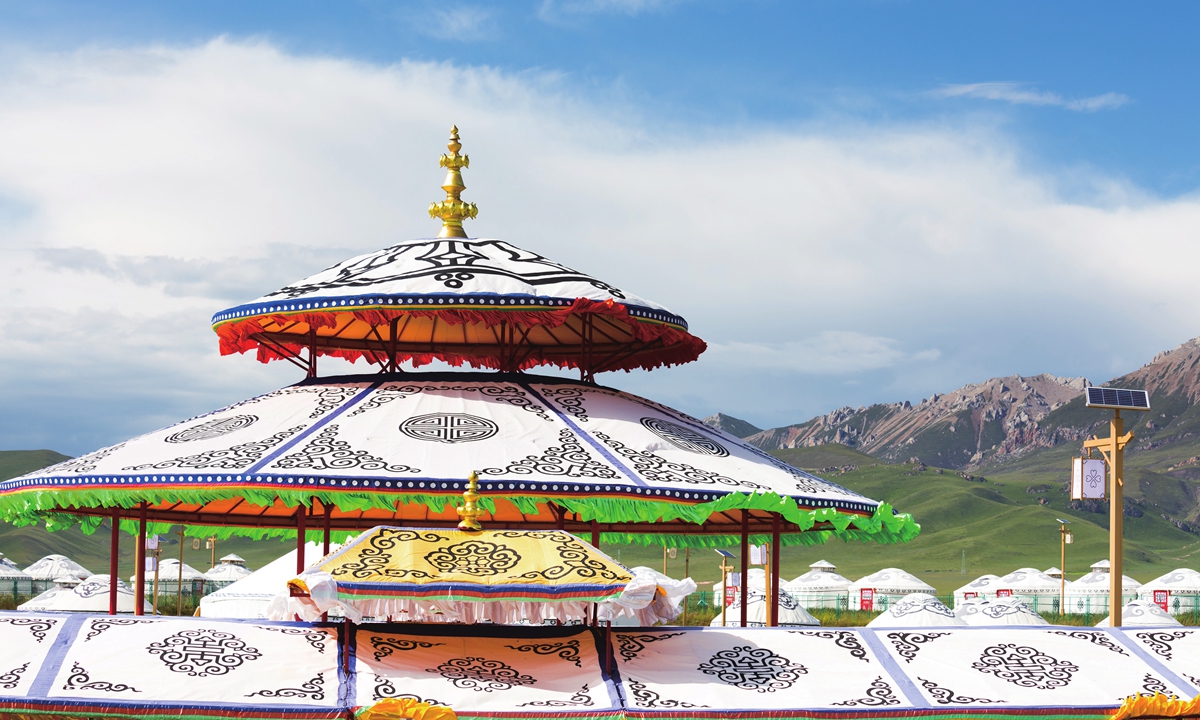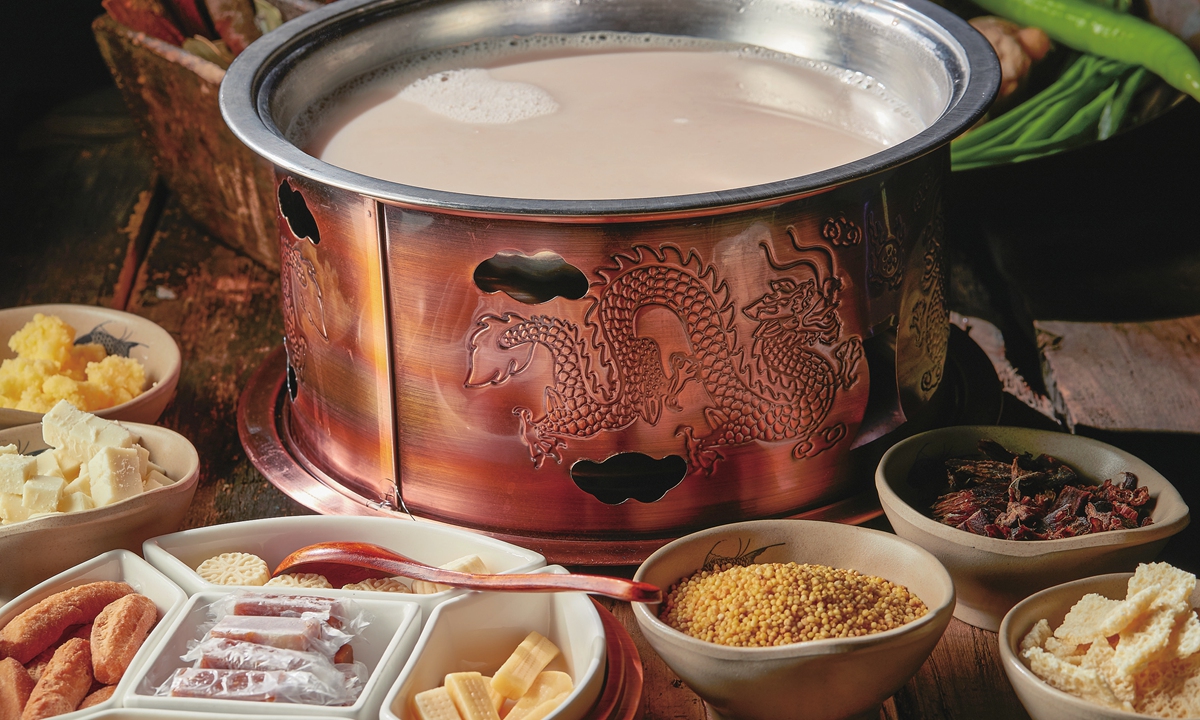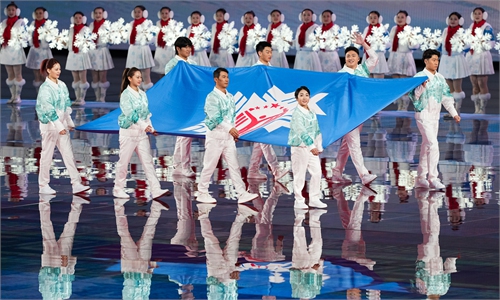ARTS / CULTURE & LEISURE
Exploring culinary diversity in National Winter Games host Hulunbuir
A fusion of ethnic flavors

A Mongolian yurt on the Hulunbuir grassland Photo: VCG

The traditional Mongolian-style milk tea Photo: VCG
During the ongoing 14th National Winter Games held in Hulunbuir, North China's Inner Mongolia Autonomous Region, visitors from across the country not only enjoy thrilling winter games, but also have the chance to taste local specialties.
The flavors characterizing the cuisine of Hulunbuir are closely connected to the local ethnic minorities. This city in the northeastern part of Inner Mongolia is home to multiple ethnic groups including Mongolian, Ewenki, Oroqen, and Daur, and each ethnic group owns its unique culinary culture and traditional delicacies developed in a long history.
Mongolian dishes
The Mongolian cuisine is deeply rooted in the nomadic lifestyle of the Mongolian people, featuring dairy and meat-based dishes.
One of the most iconic Mongolian delicacies is "roasted lamb," a traditional dish served on festive occasions. The dish consists of a whole lamb roasted until crispy on the outside and tender in the inside, and its golden hue and a good smell delight the palates of locals and visitors alike.
Another staple of Mongolian cuisine is "milk tea," a beverage made from milk and tea leaves. Enjoyed for centuries by nomadic tribes traversing the vast grasslands, traditional Mongolian milk tea has a savory flavor, which is unlike modern milk teas.
Additionally, Mongolian cheese is a beloved dairy product among Mongolian people. Made from strained yogurt, cheese has a firm texture with a tangy-sweet flavor, often enjoyed as a snack or paired with milk tea.
And, "milk tofu," a common dairy product found in the homes of Mongolian herdsmen, is also worth tasting. Getting its name due to its appearance, it is another sweet and sour delight that herdsmen soak in milk tea or use as dry food when traveling.
Traditional Ewenki cuisine
The Ewenki people are one of the indigenous ethnic groups of the Hulunbuirarea, and their traditional cuisine primarily consists of wild animals from the grasslands and fish from waterways, such as roasted wild animals and fish soup.
Those living on the grasslands, engaged in animal husbandry, rely on staples like milk tea, dairy products, hand-grabbed meat, and various types of noodles.
In agricultural areas, where farming is the main economic activity, the Ewenki people consume rice and noodles as their primary food, supplementing their diet with vegetables such as beans, cabbage, potatoes, and radish, as well as various wild vegetables.
The Ewenki people living deep in the Greater Khingan Mountains, still maintain traditional fishing and hunting practices before the founding of the People's Republic of China in 1949, thus their cuisine is influenced by fishing and hunting.
Before settling down, they primarily relied on hunted animals such as roe deer, deer, elk, and wild boar as their main sources of meat. They enjoyed drinking milk tea made from reindeer milk, eating bread, and collecting various wild fruits and vegetables.
Oroqen drinks
The area where the Oroqen people live is often abundant in rivers, lakes, and springs. In the summer, they enjoy drinking water from springs and rivers, while in the winter, they melt snow and ice to drink. As their knowledge of plants deepens, wild rose hips and birch sap have become one of the Oroqen people's favorite beverages.
Birch sap, abundant in April and May, conveys a coconut-like flavor combined with a slightly sour taste. Locals cut a notch at the base of a birch tree and the sap flows out like a small spring, clear and transparent, with a sweet taste. Originally a natural beverage made by the Oroqen people, the drink is now also available in shops.
Every autumn, on the slopes by the riverbank, clusters of red Schisandra berries hang from the trees. Local people gather the Schisandra berries, then dry and store them. When making tea, the Schisandra berries are steeped in hot water, producing a soup that is both sour and sweet. Drinking Schisandra berry soup regularly not only quenches thirst but also refreshes the mind, which is why the Oroqen people are very fond of this natural beverage.
Daur delicacies
The Daur people mainly inhabit the Nenhe River basin south of the Greater Khingan Range. The natural environment, including the abundant surface water resources and fertile land, is especially suitable for the growth of Artemisia integrifolia shoots, which is an iconic dish in Daur cuisine.
According to legend, the Daur people accidentally discovered that Artemisia integrifolia shoots were edible during a crisis, and they relied on them to overcome their difficulties.
To this day, the Daur people continue to stick to their culinary tradition. Every spring, along the banks of the Nenhe River, people gather fresh and tender Artemisia Selengensis shoots from the grasslands.
There are many ways to make dishes with the Artemisia integrifolia shoots, commonly including stewed ribs, stewed intestines, potato soup, pork dumplings, and more.
In Hulunbuir, the culinary landscape is not only shaped by each ethnic group's traditional recipes, but also by centuries of cultural exchanges.
Today, the Mongolian-style "roast lamb" is ubiquitous in local eateries, showcasing the influence of Mongolian cuisine on the region's culinary scene. Similarly, milk tea, once a staple of Mongolian culture, is now enjoyed by people of all ethnic backgrounds in Hulunbuir and birch sap beverages are commonly sold at shops in the city. And people of ethnic minorities also adopt various dishes from the Han ethnic group, such as all kinds of wheaten food.
As different ethnic groups coexist and interact, culinary traditions blend and evolve, resulting in rich flavors and the unique culinary culture of Hulunbuir.

